USPTO Update: Trademark Public Advisory Committee (TPAC) Quarterly Meeting
Nehal Madhani | October 18, 2021
On October 15, 2021, the USPTO held the Trademark Public Advisory Committee (TPAC) Quarterly Meeting, reviewing policies, goals, performance, budget, and user fees. This article provides a summary of key highlights from the meeting.
Trademarks FY2022 Priorities
Commissioner for Trademarks David Gooder outlined four primary USPTO priorities for FY2022:
- Implement the Trademark Modernization Act
- Attack trademark application surge
- Boost trademark register protection
- Intensify IT modernization
USPTO Operations Update
Deputy Commissioner for Trademark Operations Dan Vavonese discussed how the Office is handling the continuing surge in trademark application filings. The USPTO noted that currently 1,007 employees at the USPTO are dedicated to trademarks. This constitutes 7% of staffing at the USPTO. At the USPTO, there are 661 examining attorneys (with 60+/- onboarding in October), 66% of whom focus on trademarks. In 2022, the USPTO expects to hire an additional 100 examining attorneys. Due to COVID-19 restrictions, the USPTO is still in a state of “maximum telework.” To support remote work and to increase efficiencies, the USPTO is working on IT solutions to streamline work processes, including a new translations process as well as bots/tools to assist with administrative tasks.
While the USPTO is in the process of increasing staffing, the number of newly-filed trademark applications continues to climb in 2021. In FY2020, there were 738,000 new classes filed (an increase of 9.5% over 2019) and in FY2021, the USPTO is on track to receive 944,000 new classes filed (an increase of 27.5% over 2020.)
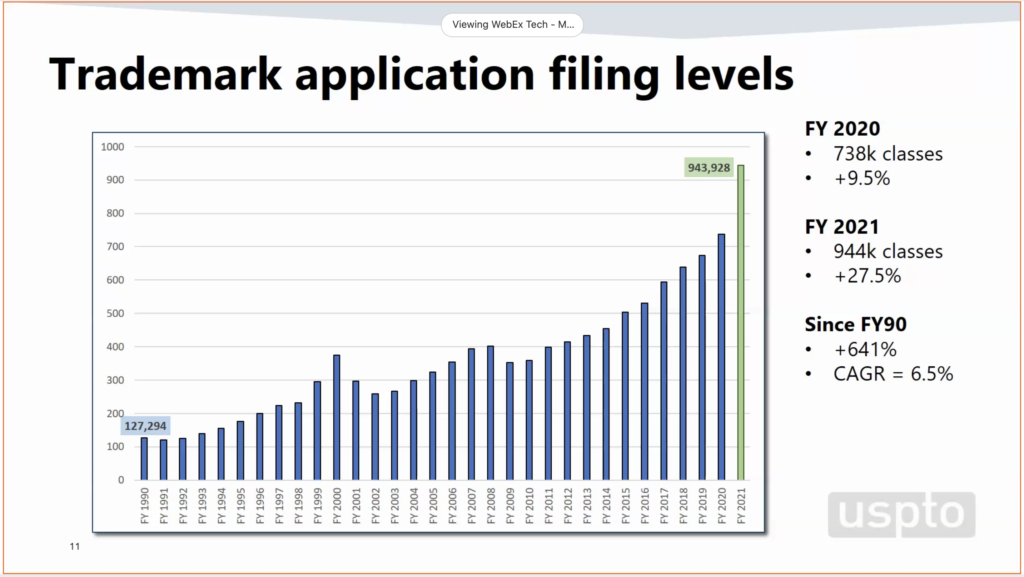
The USPTO provided a monthly breakdown showing the increase/decrease in filings relative to the prior year. The breakdown shows that more applications were filed as compared with the prior year from June 2020 – July 2021. There was a particularly notable increase in filings around December 2020 as applicants rushed to file before the USPTO fee increase took effect in 2021. Also notable, the monthly breakdown shows that over the last three months (July, August, September 2021) applications are trending down. There were fewer applications filed in July-September 2021 than in July-September 2020. However, it’s important to remember that we are comparing the 2021 application filing numbers to 2020 application filing numbers so while percentage-wise, the 2021 application filing numbers are lower than 2020, the actual volume of applications is still quite significant.
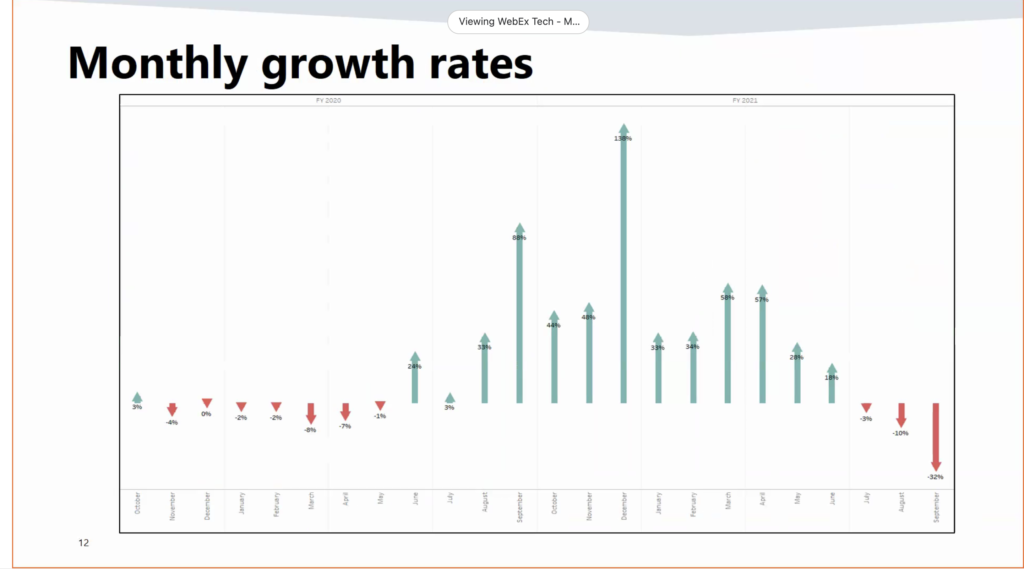
In terms of the nature of the filings and where they are originating, 60% of new USPTO trademark applications are being filed by US-based applicants. China is responsible for 24% of new applications, while the EU makes up 11%, and the rest of the world makes up 5%. The USPTO noted that Chinese applications are trending down over the course of 2021. 76% of newly-filed applications are filed by small filers (those with fewer than 10 applications) or one-time filers.
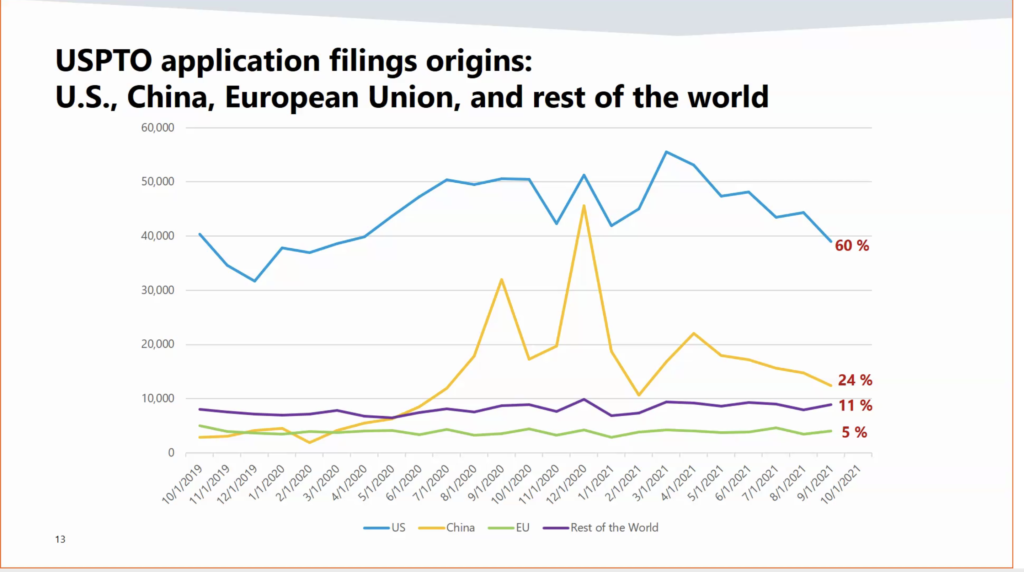
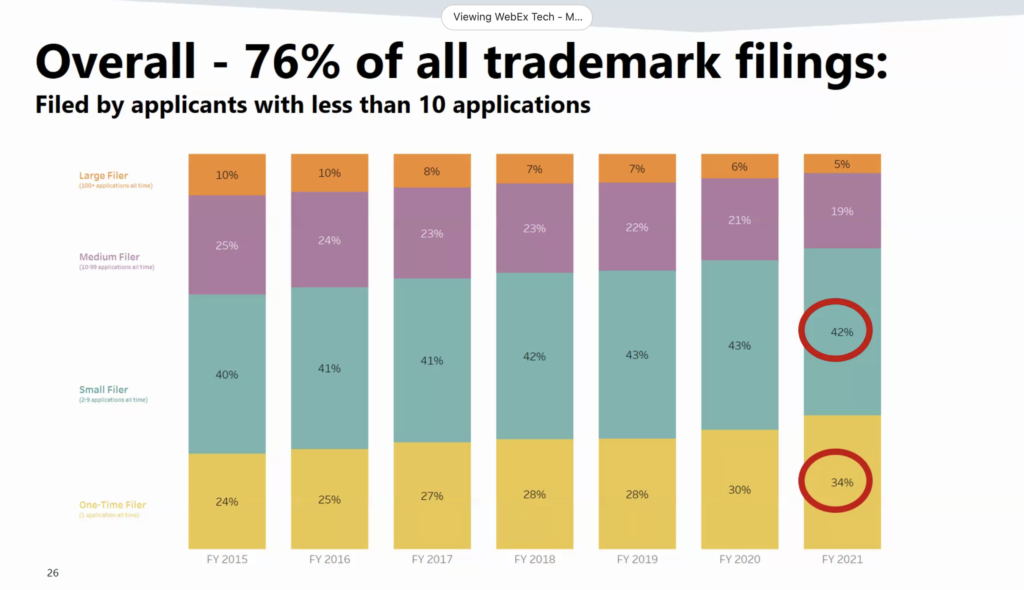
Vavonese attributed several factors to the increase in new trademark applications including:
- Growth of online sales
- Government stimulus (direct stimulus checks and government subsidies as in Guangdong province in China)
- Anticipation of USPTO fee increase in 2021
- Chinese/US law firms/lawyers directly marketing to Chinese SMEs
- Entrepreneurialism (6,714,318 new businesses started since March 2020 and more individuals having time and money to devote to new business ventures)
The USPTO reported that it is working hard to manage the new filings. The First Action Pendency—the time from when an application is filed to when the first determination is made by the Examining Attorney—is currently over 6.3 months. The USPTO acknowledged that it expects the first action pendency time to continue to climb this year, although they hope incentives will help to bring the length of time down over the course of 2022. However, the USPTO recognized that it may still be difficult to speed up the process when the Office is still dealing with such a significant backlog of newly-filed applications. While the USPTO is managing a huge quantity of newly-filed applications, the Office has placed great emphasis on the quality of examinations. In 2020, the USPTO established specific performance measures to assess the quality of trademark examination throughout 2021, specifically looking at first action compliance, final action compliance, and exceptional office action. The Office was pleased to report that examination quality has remained strong and exceeded targets throughout FY2021.
Vavonese provided transparency into the processing time for newly-filed applications and showed that while the number of unexamined classes continues to rise each month (and is currently at 499,131 in October 2021), the USPTO is still processing applications within one week of being received.
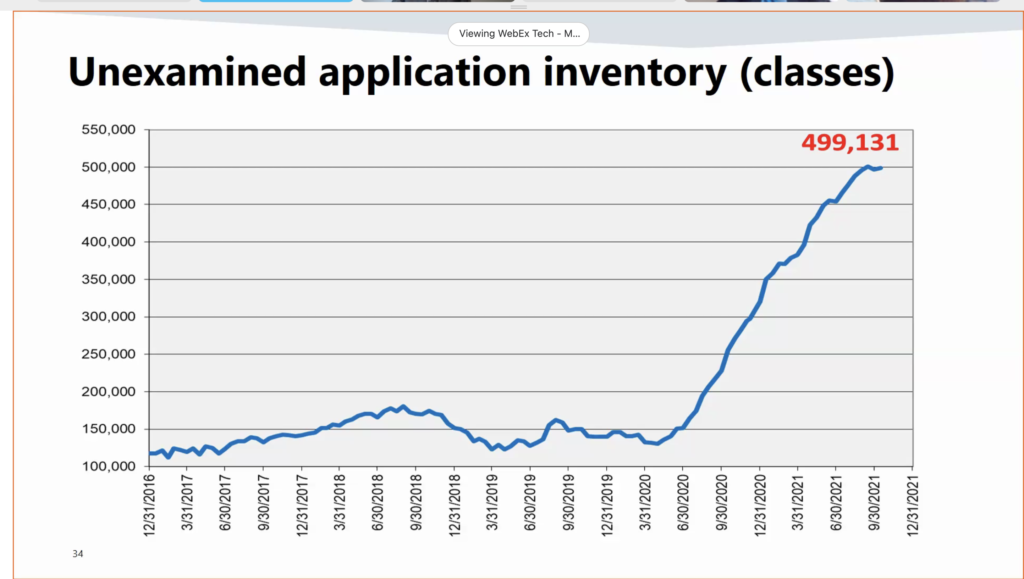
While Vavonese noted that all data submitted in an application is processed and entered into TESS and TSDR within one week, additional quality checks take longer. If an application doesn’t include international classes (a regular application where the field was empty) then it cannot get entered into the system; someone needs to review and add the class manually. It is important to include international classes when filing a TEAS regular application so that your data gets into the system as fast as possible. The USPTO was pleased to report that while there had been a significant delay in processing office action responses (90 days at one point), the period has now shrunk to 6 days. You can find the USPTO’s current processing times on its website.
Trademark Modernization Act
Deputy Commissioner for Trademark Examination Policy Amy Cotton addressed the Trademark Modernization Act, which is meant to address false claims of use in applications and in maintenance declarations. The TMA includes four major changes:
- LOP Procedure: The Letters of Protest procedure has been formalized: the procedure is the same as before, but there is now a $50 fee.
- Flexible Response Period: Office Action response periods have been shortened to no less than 60 days but are extendable to up to 6 months.
- Expungement and Reexamination: The USPTO is implementing a way to petition to cancel marks that are not in use.
- Clear deadwood off the register and facilitate mark clearance: The Office will create a procedure for identifying and clearing unused marks to clean up the register.
The USPTO has until December 27, 2021 to implement all procedures. The final rule will be issued in November 2021, and the expungement and reexamination procedures will be implemented in December 2021. The timing for the implementation of the flexible response periods is still to be determined as the final rule requires inter-agency clearance.
OIG Audit Recommendations and Administrative Sanctions
Cotton also addressed the USPTO’s address verification procedure for the US Counsel Rule. All applicants must include in their applications their domicile addresses, whether they are represented or unrepresented, and that is how the USPTO determines whether the US counsel rule is triggered. Simply because an applicant is represented does not mean they can get out of providing the domicile address. Applicants try to circumvent this rule by making up fake names and addresses,using real names that are compromised, and “renting” of credentials. As a result, the USPTO will not accept domicile addresses consisting of PO Boxes, c/o addresses, commercial mail receiving agencies, mail drops, registered agents, nonexistent or incomplete addresses, or addresses that are not actually the applicant’s domicile. The USPTO is automating the process of flagging certain types of addresses including PO boxes and c/o addresses.
The Office has set up a special task force that coordinates investigations across the agency. They investigate false claims of use, fake specimens, false attorney names/addresses and otherwise circumventing US attorney requirement, unauthorized practice of law, forged submissions, hijacked applications and brands. As for attorney misconduct and hijacking of attorney credentials, those matters are referred to the OED. There were 22 cases referred to the OED in FY2021 as a result of the improved OED referral process.
Trademarks IT Business Highlights
Deputy Commissioner for Trademark Administration Greg Dodson provided an update on the identity verification project, the integration of ID.me into the agency enterprise. The integration is expected to occur in FY2023 as the plan is split into three phases. Phase 1, requiring MyUSPTO name/password has already been implemented. Phase 2, requiring identity verification, is the next step. Phase 3, requiring authorization based on roles and database secured, is the final step. In terms of implementing Phase 2, there will be a public “soft launch” in Q1 of FY2022 where users must request access. The system will launch and be visible on TEAS in Q2 of FY2022 and verification will be voluntary. The timing for mandatory identity verification is still to be determined.